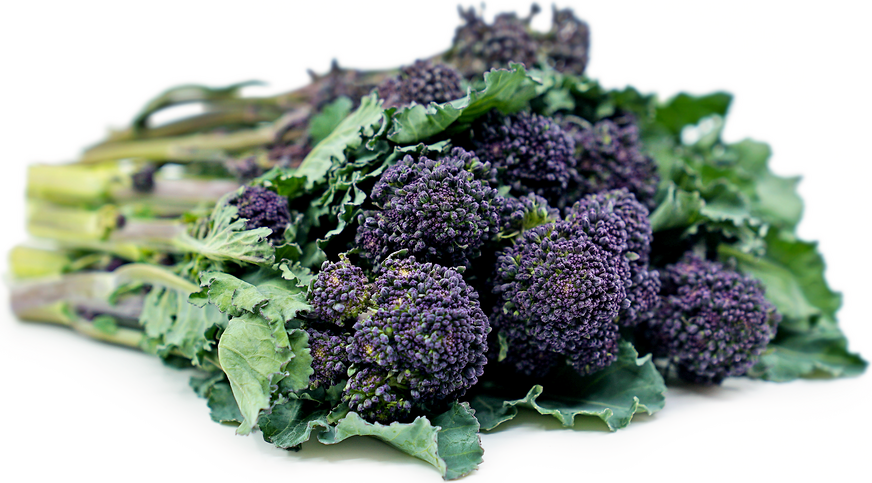


Purple Sprouting Broccoli
Estimated Inventory, lb : 0
This item was last sold on : 04/18/25
Description/Taste
Purple broccoli develops large, silvery-green leaves on stiff stems growing in whorls around a green central stalk. The plant produces a small, deep purple central head made of tiny flower sprouts, and nearly a dozen similarly sized heads on thinner stalks. Individual spears are harvested around 13 centimeters long for bunching and to promote the growth of additional heads. Purple broccoli offers a nutty, peppery flavor with the subtle sweetness and bitterness common to all Brassica vegetables. Our Purple Broccoli is from Weiser Family Farms located in Tehachapi, California, about 100 miles north of Los Angeles. The farm naturally thrives from the unique growing climate that includes warm summer days and invaluable spring rains.
Seasons/Availability
Purple broccoli is available in the late winter and through the early spring months.
Current Facts
Purple broccoli is a sprouting type, and a member of the Brassicaceae family. It is botanically classified as Brassica oleracea var. italica and is an heirloom variety that was once called Asparagus broccoli by the infamous French seed catalog, Vilmorin. Purple broccoli, as with other cruciferous cultivars, is a cool season plant and is sometimes referred to as ‘winter sprouting broccoli.’ There are several different named cultivars of Purple broccoli, including Bordeaux, Claret, Nine Star, Red Arrow, Red Head and Red Spear.
Nutritional Value
Purple broccoli is an excellent source of vitamin C and a great source of vitamins K and A. It is also a good source of folates, B-complex vitamins, manganese and iron. Purple broccoli is a source of a moderate amount of dietary fiber, potassium, protein, calcium, copper, magnesium, and selenium, and contains trace amounts of zinc and sodium. It also contains phytonutrients and flavonoids like lutein and zeaxanthin, which provide beneficial antioxidants.
Applications
Purple broccoli is more versatile than common broccoli as it is naturally more tender and cooks quickly under high heat while still retaining its textural integrity. It will, however, lose its purple hue due to the high heat. It can be sautéed, steamed, roasted, grilled and fried. It is well-suited for fresh eating alone or on a crudité platter. Add spears to pastas, risotto or use as a pizza topping. Purple broccoli's flavor marries well with seasonal spring companions such as leeks, kale, chicory, green garlic and citrus. Pair it with butter, olive oil, light-bodied vinegars, tomatoes, chiles, cured meats such as pancetta and prosciutto, flaky white fish, hard cheeses like parmesan and pecorino or fresh cheeses like chevre and feta. Store Purple broccoli wrapped in plastic in the refrigerator for up to 2 weeks.
Ethnic/Cultural Info
Scientists believe the naturalist Pliny was referring to Purple broccoli when he described “Bruttium broccoli” in the first century CE. Bruttium refers to the land at the southernmost tip of Italy, or what is now Calabria. It has also been referred to as Christmas Calabrian broccoli. The word “Calabrese” is used to refer to heading varieties of green broccoli throughout Europe, in the United Kingdom and especially Italy. The term ‘Cape’ is often used to describe colored varieties of heading broccoli. In Italy, Ireland and the United Kingdom, the term ‘broccoli’ is used to refer to Purple broccoli and white sprouting types, including cauliflower.
Geography/History
Purple broccoli is native to the eastern Mediterranean and Central Asian region and was first cultivated in Southern Italy. Seeds for “Sprouting Purple broccoli” were first listed in the French Vilmorin-Andrieux seed catalog in 1885, which also introduced the colorful cultivar to the United States. Prior to the early 1980s, Purple broccoli was little known outside of England and Italy until two English breeders, Alan Gray and P. Crisp, began working on selecting hardier, better tasting plants and introduced seeds for an improved cultivar in 1985 that could be commercialized. Sprouting broccoli requires a longer growing season as they are planted in the late spring and not harvested until the winter or spring of the following year. The long length of time and multiple seasons it takes to bring crops to harvest can be cost, space and time prohibitive and Purple broccoli is not grown commercially. It is most likely spotted at farmer’s markets in Italy, United Kingdom and Southern California.
Recipe Ideas
Recipes that include Purple Sprouting Broccoli. One
| Super Golden Bakes |
|
Spring Tart with Ricotta, Leek, and Broccoli |
| The Happy Foodie |
|
Purple Sprouting Broccoli with Clementine and Chilli |

















